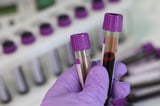Routine Blood Test Predicts Preeclampsia Risk, New Study Reveals
October 22, 2024
A recent study presented at the ANESTHESIOLOGY 2024 annual meeting indicates that a routine blood test can predict the risk of preeclampsia in women entering labor.
Researchers found that measuring the fibrinogen-to-albumin ratio (FAR) during standard blood tests can help assess a woman's risk of developing preeclampsia upon hospital admission.
Preeclampsia affects between 5% and 10% of pregnant women and can lead to severe complications such as premature birth, organ damage, and increased risks for both mother and child.
Precautionary measures for women at risk of preeclampsia include more frequent blood pressure monitoring and early pain management.
Women with an elevated FAR could see a risk increase of up to 41% for developing this serious pregnancy complication.
Fibrinogen is crucial for blood clotting and inflammation, while albumin helps maintain fluid balance and transport essential substances in the body.
Higher levels of FAR indicate increased inflammation and potential health issues, with specific risk thresholds identified in the study.
Shang also highlighted the importance of FAR as a predictive tool, particularly for high-risk groups such as Black women and those with chronic conditions.
Lead researcher Lucy Shang, a medical student at the Icahn School of Medicine, emphasized that FAR can be a valuable predictive tool for healthcare providers.
Black women are 60% more likely to develop preeclampsia than white women and face higher risks of severe health outcomes.
Obstetricians can take preventive measures for women identified at risk based on FAR and other clinical indicators, such as age and pre-existing conditions.
Further research is necessary to establish normal FAR ranges and improve routine prenatal care for early detection of preeclampsia.
Summary based on 4 sources
Get a daily email with more Science stories
Sources

U.S. News & World Report • Oct 21, 2024
Blood Test Might Spot Women in Labor at Risk for Preeclampsia
Medical Daily • Oct 21, 2024
Simple Blood Test Before Labor May Help Predict Preeclampsia: Researchers Say
healthday-en • Oct 21, 2024
Blood Test Might Spot Women in Labor at Risk for Preeclampsia